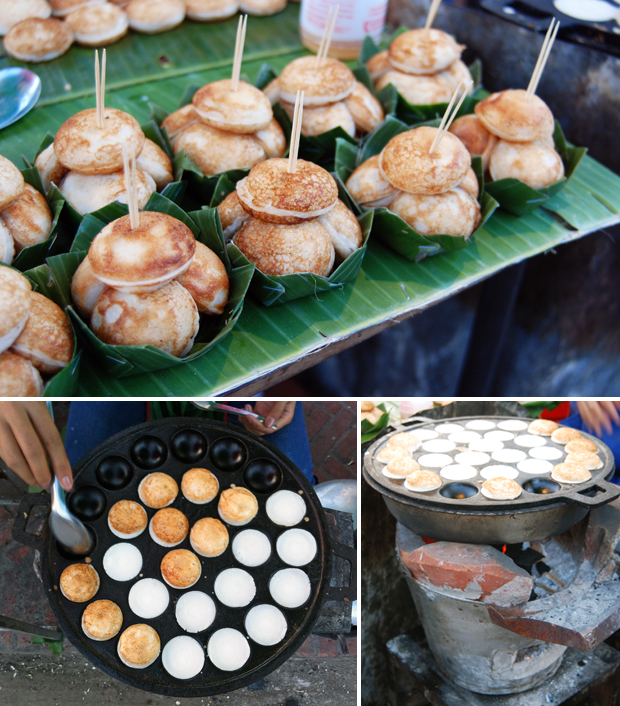Luang Prabang, LAOS – As you stroll through the night market, there’s a good chance you’ll end up gobbling down khao nom kok, bite-sized Lao coconut cakes. Made with rice flour and coconut cream, these sweet street treats are ridiculously tasty, addictive and easy to make.
Khao nom kok (also written kanom, kha nom, or in Thai, kanom krok) is made in an eye-catching cast iron pan with half-moon indents over a charcoal brazier. The thin batter is poured into the rounds and once cooked golden brown, two of them are sandwiched together. They are served piping hot in a cup fashioned out of a banana leaf. The outsides are a little bit crisp, the insides moist, silky and melt in your mouth soft.

You can find them in Luang Prabang’s morning market. Nosh on them with a cup of strong, thick Lao coffee. You will also no doubt also find the Thai version at street stalls and markets all over Thailand. A savoury version of this can be found in southern Laos. Khao nom kok Pakse (Pakse-style coconut cakes) are stuffed with minced pork and served with a sweet and sour dipping sauce.
Recipe for khao nom kok – Lao coconut cakes
This recipe was kindly provided by Maison Souvannaphoum Hotel, a boutique hotel in Luang Prabang that was once the residence of Prince Souvannaphouma, four-time Prime Minister of Laos. It’s a tried and true recipe – they make these on the spot for guests as a breakfast treat every morning.
Locals in Luang Prabang would insist that a charcoal brazier is the best way to cook all meals – though it’s probably not feasible for you. It would be easiest if you bought the pan while in Laos, Thailand or Vietnam (a Vietnamese banh khot pan is similar). If you’re in Luang Prabang you can buy them at Phosi Market or Naviengkham Market. At home, you can use the more readily available Dutch pancake “poffertjes” pan, or try finding it at your Asian cookery specialty shop.
Ingredients for Khao Nom Kok
Rice flour 75 grams
Sticky rice flour 25 grams
Sugar 50 grams
Coconut cream 350 ml
Water 50 ml
Salt ½ teaspoon
Instructions
1. In a bowl, mix the rice flour, sticky rice flour, sugar, coconut cream, water and salt until smooth.
2. Place the pan on the fire, allowing it to thoroughly heat up. Or heat up the Dutch pancake pan on the stove. The pan needs to be hot enough or else the cakes will stick.
3. Grease each round with vegetable oil.
[video_embed maxwidth=”600″][/video_embed](Video from Maison Souvannaphoum, showing how it’s done)
4. Pour the batter into each round. The Lao use a teapot or a plastic water bottle to pour the batter. It makes it much easier!
5. Cook for 4-5 minutes. Check to see if the outsides are browned by gently pulling the sides away from the pan with an oiled spoon or small spatula.
6. The flip! Once the outsides are golden brown, gently lift the cake and flip it on top of another that is ready.


Pingback: Luang Prabang – Bed Bugs and the Kuang Si Waterfall | onewayfarers()